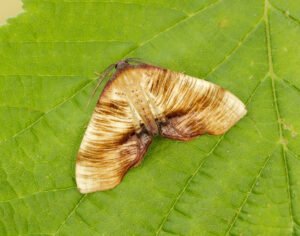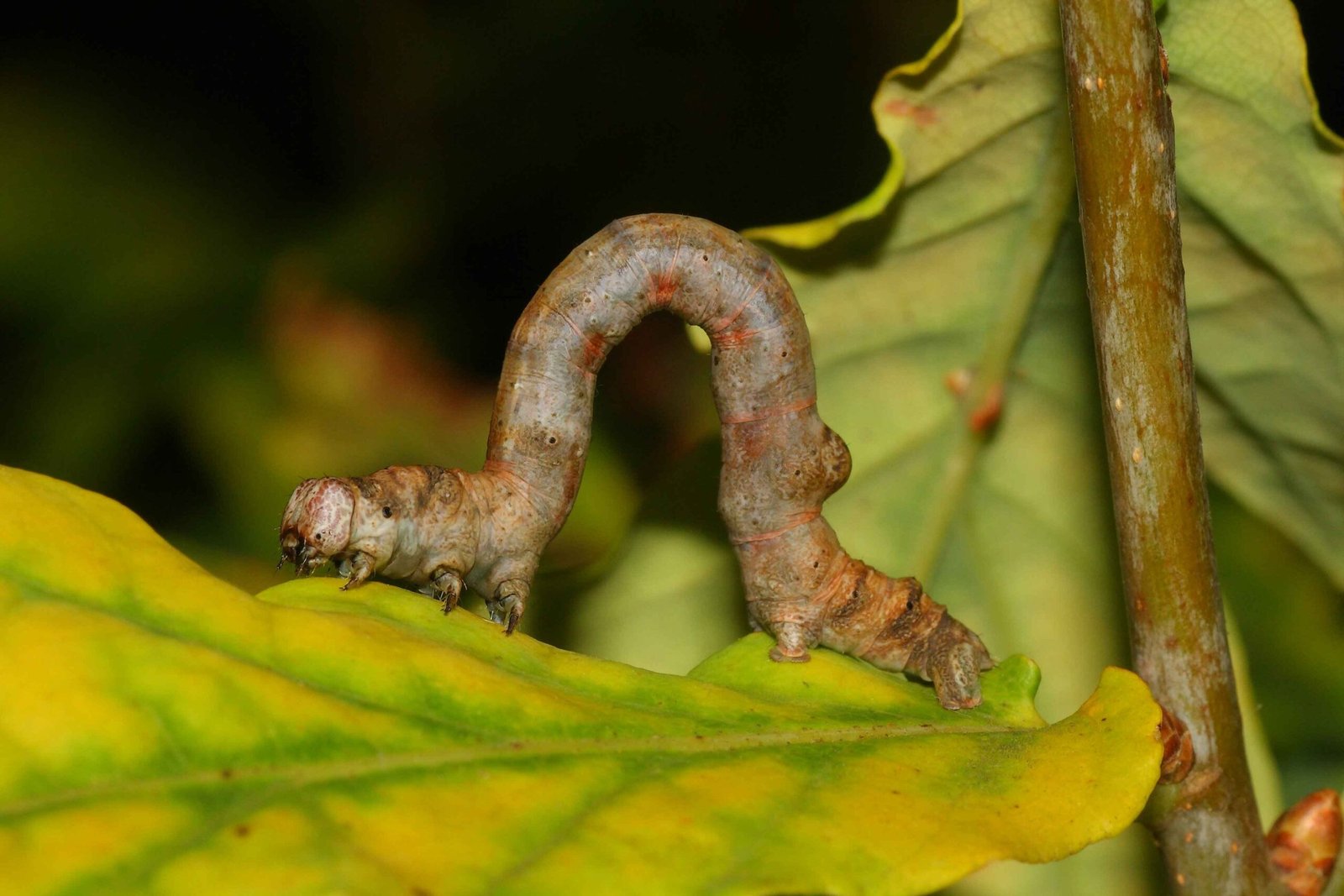Introduction to the Scorched Wing Moth Caterpillar
The scorched wing moth caterpillar, known scientifically as the Plagodis dolabraria, represents a fascinating segment of the Lepidoptera order. This order is characterized by winged insects that undergo a complete metamorphosis, transitioning from egg to larva, then pupa, and finally, to adult moth. The scorched wing moth is part of the Geometridae family, commonly referred to as geometer moths, which are known for their measuring or “geometry” like movements during their caterpillar phase.
In its caterpillar form, the scorched wing moth exhibits remarkable adaptations that not only help it thrive in its natural environments, but also make it an intriguing subject of study for entomologists and nature enthusiasts alike. These caterpillars are typically found in a variety of habitats, including open woodlands, shrubby areas, and even gardens. They prefer environments where host plants remain abundant, as caterpillars are herbivorous and derive their nutritional needs from consuming leaves.
One prominent characteristic of the scorched wing moth caterpillar is its distinctive coloration and patterning, which often aids in camouflage against potential predators. This caterpillar can exhibit shades of green and brown, with markings that resemble the foliage it resides on, thereby providing a protective advantage. Additionally, they are known to display a unique posture when disturbed, curling up and playing dead as a defensive mechanism.
The unique features and behaviors of the scorched wing moth caterpillar emphasize its ecological role within its habitat. The species undergo significant changes as it develops, ultimately leading to the emergence of the adult moth, which possesses intricate wing patterns that captivate observers. The entire life cycle of the scorched wing moth, including its larval stage, presents a captivating example of nature’s resilience and adaptability, which is why this species garners interest among those who observe and study the natural world.
Life Cycle of the Scorched Wing Moth Caterpillar
The life cycle of the scorched wing moth caterpillar is a remarkable journey of transformation that captivates entomologists and nature enthusiasts alike. The cycle begins when the female moth lays eggs, typically on the underside of leaves in favorable habitats such as woodlands and gardens. These eggs are small, often measuring only a few millimeters, and are camouflaged to blend in with the foliage, providing protection from predators.
After a short incubation period, which generally lasts about one to two weeks, the eggs hatch into the first instar caterpillars. These tiny caterpillars are initially very small and consume the leaf material around them to sustain their growth. As they feed, they undergo a series of molts, progressing through five or six instars over the course of several weeks. This phase, where the larva is actively feeding, is crucial for their development. The scorched wing moth caterpillar is typically green or brown, allowing it to remain concealed in its environment.
Once they have reached a sufficient size, they enter the pupal stage of their life cycle. The caterpillar will often seek a secure location, such as the bark of a tree, where it will form a protective casing or chrysalis. This pupal stage can last from several weeks to months, depending on environmental factors such as temperature and humidity. Inside this protective layer, the caterpillar undergoes amazing physiological changes as it metamorphoses into the adult moth.
Finally, when conditions are optimal, the fully formed adult moth emerges from the pupa. Initially, its wings are crumpled and wet, but as they dry and expand, the scorched wing moth takes to the skies. This entire life cycle, from egg to adult, showcases the incredible adaptability and resilience of the scorched wing moth caterpillar, reflecting the broader ecological interactions within its habitat. Understanding each stage of this life cycle highlights the beauty and complexity of this fascinating insect.

Behavior and Adaptations of the Scorched Wing Moth Caterpillar
The scorched wing moth caterpillar exhibits intriguing behaviors and adaptations that enhance its survival in a range of environments. One of its primary feeding habits involves consuming a variety of host plants, typically selecting those that provide optimal nutrition. The preferred plants often belong to the families of leafy greens where the caterpillar can readily access nutrients essential for its development. Such plants not only support the caterpillar’s growth but also play a vital role in its ecological interactions.
Camouflage is one of the most remarkable adaptations of the scorched wing moth caterpillar. Its coloration and body morphology enable it to blend seamlessly into its surroundings, mimicking twigs and leaves. This natural disguise proves advantageous as it helps evade the keen eyesight of potential predators such as birds and other insects. When threatened, the caterpillar may also employ defensive postures, curling up or adopting a stiff body stance, further enhancing its resemblance to inanimate objects in its habitat.
In terms of defensive strategies, the scorched wing moth caterpillar possesses unique chemical defenses. Some species within this group are known to secrete substances that can deter predators or can even be toxic when ingested. This chemical strategy not only aids in immediate survival but also influences the feeding behavior of predators, contributing to the overall dynamics of predator-prey interactions within their ecosystem.
The ecological role of the scorched wing moth caterpillar extends beyond its immediate survival strategies. As a herbivore, it plays an essential part in controlling plant populations, while also serving as a food source for various wildlife including birds, reptiles, and amphibians. This interconnectedness underscores the importance of the scorched wing moth caterpillar within the food web, highlighting its integral contribution to sustaining biodiversity.
Conservation and Observing the Scorched Wing Moth Caterpillar
The scorched wing moth caterpillar plays a crucial role in the ecosystem, serving as a food source for various predators and contributing to the biodiversity that sustains healthy environments. However, like many insect species, it faces several threats, including habitat loss, climate change, and pesticide use. These challenges make conservation efforts essential to ensure the survival of the scorched wing moth caterpillar and its habitat.
To effectively observe these fascinating caterpillars, enthusiasts should seek natural areas where they are most commonly found, such as meadows, woodlands, and areas with abundant vegetation. The larval stage typically occurs on specific host plants, making their identification an important skill for amateur naturalists. Enthusiasts can look for distinctive characteristics of the scorched wing moth caterpillar, such as its coloration and pattern, to aid in identification. Respectfully observing these creatures involves minimizing disturbance to their environment and avoiding any actions that could harm their population.
Participating in or supporting local conservation initiatives can significantly impact the preservation of the scorched wing moth caterpillar‘s habitat. Such efforts often include habitat restoration, community education about the importance of biodiversity, and research regarding the species and its needs. By advocating for environmentally friendly practices, individuals can contribute to a more sustainable future for these remarkable caterpillars.
Overall, the survival of the scorched wing moth caterpillar is closely linked to the health of its environment. Recognizing the importance of each species within an ecosystem is fundamental to understanding the broader implications of biodiversity. Those interested in studying or observing these unique insects should approach their efforts with care, dedication, and a commitment to conservation. In conclusion, responsible observation and active participation in conservation efforts are paramount to ensuring a future where the scorched wing moth caterpillar continues to thrive in its natural habitat.






